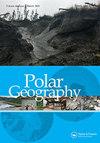使北极可预测:北极天气和海冰服务信息基础设施的变化
IF 1.6
Q3 GEOGRAPHY, PHYSICAL
引用次数: 15
摘要
摘要:本文探讨了北极地区气候和海冰信息提供的变化基础设施。传统上,海冰和天气状况业务信息的最重要提供者是国家海冰和气象服务机构。近年来,北极信息提供者的多样性日益增强,协作平台日益增多。三个案例研究将增强我们对当前发展的理解(巴伦支观察、极地观点和北极网)。我们分析他们的组织和资金结构,他们开发的服务类型,以及他们的目标群体。基于这些案例,我们讨论了信息基础设施的动态和变化的潜在驱动因素。除了由于北极活动模式的变化而对定制服务的预期需求外,由于以下因素的结合,新的倡议也出现了:(1)信息和通信技术的进步,(2)需要加强数据系统的互操作性,(3)以及希望改善从提供商到用户的定制数据传输。本文最后讨论了北极信息基础设施变化的影响,并确定了进一步研究的方向。本文章由计算机程序翻译,如有差异,请以英文原文为准。
Making the Arctic predictable: the changing information infrastructure of Arctic weather and sea ice services
ABSTRACT This paper explores the changing infrastructure around weather and sea ice information provisioning for Arctic marine areas. Traditionally, the most important providers of operational information on sea ice and weather conditions are the national sea ice and meteorological services. More recently, the community of Arctic information providers has become more heterogeneous with the establishment of numerous collaborative platforms. Three case studies will enhance our understanding of current developments (BarentsWatch, Polar View and Arctic Web). We analyze their organization and funding structures, the types of services they develop, and their target groups. Based upon these cases, we discuss the information infrastructure’s dynamics and underlying drivers of change. Apart from an expected need for customized services due to changing Arctic activity patterns, new initiatives arise due to a combination of (1) progress in information and communication technology, (2) a need to enhance interoperability of data systems, (3) and a desire to improve customized data conveyance from provider to user. The paper concludes with a discussion of the implications of the changing Arctic information infrastructure and defines directions for further research.
求助全文
通过发布文献求助,成功后即可免费获取论文全文。
去求助
来源期刊

Polar Geography
GEOGRAPHY, PHYSICAL-
CiteScore
5.30
自引率
0.00%
发文量
13
期刊介绍:
Polar Geographyis a quarterly publication that offers a venue for scholarly research on the physical and human aspects of the Polar Regions. The journal seeks to address the component interplay of the natural systems, the complex historical, political, economic, cultural, diplomatic, and security issues, and the interchange amongst them. As such, the journal welcomes comparative approaches, critical scholarship, and alternative and disparate perspectives from around the globe. The journal offers scientists a venue for publishing longer papers such as might result from distillation of a thesis, or review papers that place in global context results from coordinated national and international efforts currently underway in both Polar Regions.
 求助内容:
求助内容: 应助结果提醒方式:
应助结果提醒方式:


